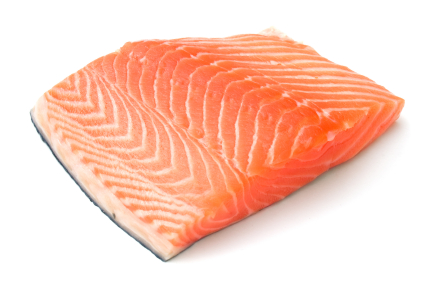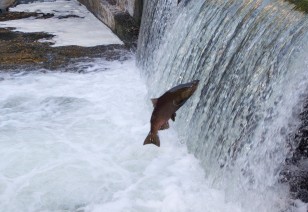 An endangered chum salmon attempts to jump a small dam on the Deschutes River in Washington. While researching my post on Cheesecake Factory, I came upon contradictory information on how many pounds of wild fish it takes to create a pound of farmed salmon.
An endangered chum salmon attempts to jump a small dam on the Deschutes River in Washington. While researching my post on Cheesecake Factory, I came upon contradictory information on how many pounds of wild fish it takes to create a pound of farmed salmon.
Industry sources like this one paint a (relatively) rosy picture: “Every pound of salmon requires one-and-a-half pounds of fishmeal, a ratio far more efficient than other farmed animals.” That’s a much better feed conversion ratio than you get from beef (10 pounds of feed yield one pound of beef) or pork (5:1).
But then you get sources like Dan Imhoff, who refers to the “approximately three pounds of wild fish needed to produce each pound of farmed salmon.”
What gives? I turned to Taras Grescoe, author of Bottomfeeder: How to Eat Ethically in a World of Vanishing Seafood, which I consider the most important book on food politics since Omnivore’s Dilemma. I remembered from reading the book that Grescoe had debunked the industry claim, but couldn’t remember precisely how or find my copy. So I emailed him to ask. Here’s what he wrote:
The salmon farming industry deliberately tries to mislead people with this feed conversion stuff; I find it maddening. The salient figure is not how much feed gets turned into salmon flesh (and the industry has indeed gotten better at that-a lot of the feed used to just fall to the bottom of the ocean. Now they’ve installed underwater cameras, so they can see when the fish have stopped snapping up the feed.) The salient figure is how many pounds of smaller ocean fish (which are converted into feed) it takes to make a pound of salmon flesh.
In other words, the industry is getting up to some chicanery here. They’re comparing apples (pounds of feed) to oranges (pounds of fish). So what happens when you compare pounds of wild fish that gets turned into feed, to pounds of resulting farmed fish? Here’s Grescoe in his email:
The analysts I talked to put the ratio at closer to 3.9 to 1. That’s almost 4 pounds of smaller fish (anchoveta from Peru, for example, or herring, as well as krill, which is truly a disastrous thing to remove from the food chain-see my book on that one) to make one pound of salmon.
That’s just scandalous. Anchovies are a glorious food–delicious as a flavor builder in canned form, fantastic grilled when fresh. They’re a nutritional powerhouse, they don’t accumulate much mercury, and their stocks replenish rapidly. We’d make ourselves very happy by eating more of them–so why are we grinding them into meal, pelletizing them along with some truly dodgy ingredients (see below), and feeding them to miserable confined salmon?
But really, it gets worse. After writing the Cheescake Factory post, I found my copy of Bottomfeeder. In his email, Grescoe suggested I look up his section on krill, which he describes like this:
These small, translucent, shrimp-like invertebrates are a keystone species in the oceans of the world, filtering the minute phytoplankton that other species are unable to process and sequestering atmospheric carbon through their feces, which sinks to the sea floor.
Moreover, “everything in the ocean from anchovetas and penguins to blue whales” feed on krill.
Sounds like a species worth keeping around. Even without the fishmeal industry, krill are under pressure–in Antarctic waters, populations have plunged “as global warning decreases the sea ice coverage that provides habitat for the plankton the krill need to survive.” That’s a feedback spiral–krills sequester carbon, and as climate change erodes their population, less carbon gets sequestered, triggering more climate change.
But that has not stopped the salmon-feed industry. According to Grescoe, two European companies–EWOS and Skretting–control 80 percent of the salmon-feed market. And their pellets “are coated in krill to make them palatable to farmed fish.” Grescoe reports that “enormous vessels from six different countries are vacuuming up krill” to satisfy demand. Krill fishing has been banned on the U.S. west coast, but the salmon farms that supply us still consume the stuff en masse.
The book also reveals some real gross-out stuff about salmon feed. Writes Grescoe:
In the wild, salmon are top-of-the-food-chain predators, subsisting, at various times in their lifecycle, on plankton, krill, squid, and smaller fish. Industrial aquaculture, however, has turned them into consumers of some of the nastier byproducts of land animals.
That means that as with the rations of of feedlot cows, salmon feed contains poultry meal–“an industrial product made of intestines, undeveloped eggs, spray-dried blood, necks, and feet of poultry.” An that’s not all: “chicken manure–a potentially rich source of tape worms, salmonella, and arsenic–is also a key ingredient of salmon feed.”
So we’re feeding not just chicken parts but also chickenshit to salmon.
Grescoe also notes that, in response to criticisms of depleting wild fish stocks to feed farmed fish, companies are substituting some vegetable oil (mainly from genetically modified rapeseed) for fish oil. But that’s not great, either. Rising demand for veggie oil puts pressure on ecologically fragile land, including tropical rainforests that sponge carbon. Moreover, subbing veggie oil for fish oil reduces the amount of omega 3 fatty acids in the the resulting farmed fish, Grescoe reports. Of course, the industry markets farmed salmon as an excellent source of omega-3s.
Of course, the answer to these dilemmas isn’t for restaurants like Cheesecake Factory to switch their menus to wild-caught salmon year round. The answer is to think of salmon as a delicacy–to be enjoyed fresh when it’s in season in places like the northwest, and as a treat in preserved form elsewhere. Rather than menu subsitutions, we need to be moving toward what Wendell Berry has called the “universal necessity of local adaptation.” Every area, every season has its culinary delights and nutritional powerhouses. We need to reacquaint ourselves with them.
At any rate, anyone interested in understanding the full weight of the trouble facing the oceans–and the full depravity of industrial aquaculture–must read Grescoe’s book.




